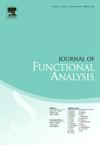Restrictions of pure states to subspaces of C⁎-algebras
IF 1.6
2区 数学
Q1 MATHEMATICS
引用次数: 0
Abstract
Given a unital subspace M of a -algebra B, the fundamental problem that we consider is to describe those pure states ω on B for which , where is the set of states on B extending . In other words, we aim to understand when admits a unique extension to a state on B. We find that the obvious necessary condition that also be pure is sufficient in some naturally occurring examples, but not in general. Guided by classical results for spaces of continuous functions, we then turn to noncommutative peaking phenomena, and to several variations on noncommutative peak points that have previously appeared in the literature. We illustrate that all of them are in fact distinct, address their existence and, in some cases, their relative abundance. To solve our main problem, we introduce a new type of peaking behaviour for ω, namely that the set be what we call an M-pinnacle set. Roughly speaking, our main result is that admits a unique extension to B if and only if is an M-pinnacle set.
C -代数的纯态对子空间的限制
给定C -代数B的一个一元子空间M,我们考虑的基本问题是描述B上的纯态ω,其中ω是B上扩展ω|M的态的集合。换句话说,我们的目的是了解ω|M在什么情况下允许对b上的状态有唯一的扩展。我们发现ω|M也是纯的这个明显的必要条件在一些自然发生的例子中是充分的,但不是一般的。在连续函数空间的经典结果的指导下,我们然后转向非交换峰值现象,以及以前在文献中出现的非交换峰值点的几种变化。我们说明,所有这些实际上是不同的,解决他们的存在,在某些情况下,他们的相对丰富。为了解决我们的主要问题,我们引入了ω的一种新的峰值行为,即集合Eω是我们所说的m -顶峰集。粗略地说,我们的主要结果是ω|M允许唯一扩展到B当且仅当ω是M-尖峰集。
本文章由计算机程序翻译,如有差异,请以英文原文为准。
求助全文
约1分钟内获得全文
求助全文
来源期刊
CiteScore
3.20
自引率
5.90%
发文量
271
审稿时长
7.5 months
期刊介绍:
The Journal of Functional Analysis presents original research papers in all scientific disciplines in which modern functional analysis plays a basic role. Articles by scientists in a variety of interdisciplinary areas are published.
Research Areas Include:
• Significant applications of functional analysis, including those to other areas of mathematics
• New developments in functional analysis
• Contributions to important problems in and challenges to functional analysis

 求助内容:
求助内容: 应助结果提醒方式:
应助结果提醒方式:


